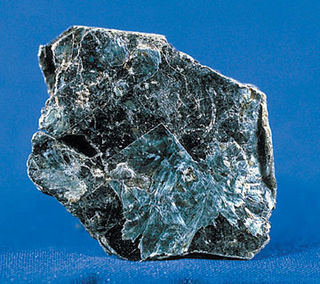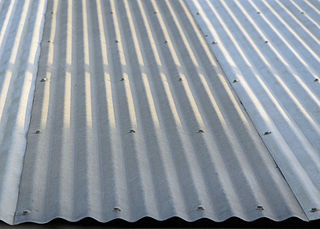
Vermiculite is a hydrous phyllosilicate mineral which undergoes significant expansion when heated. Exfoliation occurs when the mineral is heated sufficiently; commercial furnaces can routinely produce this effect. Vermiculite forms by the weathering or hydrothermal alteration of biotite or phlogopite. Large commercial vermiculite mines exist in the United States, Russia, South Africa, China, and Brazil.

Canberra Stadium is a facility primarily used for rugby league and rugby union games, located adjacent to the Australian Institute of Sport in Canberra, the capital of Australia. It is the largest sports venue by capacity in Canberra.
James Hardie Industries plc is a global building materials company and the largest global manufacturer of fibre cement products. Headquartered in Ireland, it is a dual-listed company, being listed on the Australian and New York Stock Exchanges. Its management team currently sits in Chicago, Illinois, United States. James Hardie was plagued by several asbestos-related scandals in the 20th century.
CSR Limited is a major Australian industrial company, producing building products and having a 25% share in the Tomago aluminium smelter located near Newcastle, New South Wales. It is publicly traded on the Australian Securities Exchange. In 2021, it had over 3,000 employees and reported an after-tax profit of $146 million. The company has a diversified shareholding with predominantly Australian fund managers and retail owners. The group's corporate headquarters is in North Ryde, Sydney.
The mineral asbestos is subject to a wide range of laws and regulations that relate to its production and use, including mining, manufacturing, use and disposal. Injuries attributed to asbestos have resulted in both workers' compensation claims and injury litigation. Health problems attributed to asbestos include asbestosis, mesothelioma, lung cancer, and diffuse pleural thickening.

Wittenoom is a former town and a declared contaminated site, 1,420 kilometres (880 mi) north-north-east of Perth, in the Hamersley Range in the Pilbara region of Western Australia. The declared contaminated site comprises 50,000 hectares, making it the "largest contaminated site in the southern hemisphere".

Asbestos cement, genericized as fibro, fibrolite, or AC sheet, is a composite building material consisting of cement and asbestos fibres pressed into thin rigid sheets and other shapes.

The Cameron Offices are a series of former government offices commissioned by the National Capital Development Commission and designed by John Andrews in the Brutalist structuralism style of architecture. The offices were constructed between 1970 and 1976 and partially demolished during 2007–08. They are located in the Belconnen Town Centre, in the district of Belconnen, located in Canberra, in the Australian Capital Territory, Australia.

Building insulation materials are the building materials that form the thermal envelope of a building or otherwise reduce heat transfer.

Radburn design housing is a concept for planned housing estates, based upon a design that was originally used in the community of Radburn within Fair Lawn, New Jersey, United States.

Asbestos is a naturally occurring fibrous silicate mineral. There are six types, all of which are composed of long and thin fibrous crystals, each fibre being composed of many microscopic "fibrils" that can be released into the atmosphere by abrasion and other processes. Inhalation of asbestos fibres can lead to various dangerous lung conditions, including mesothelioma, asbestosis, and lung cancer. As a result of these health effects, asbestos is considered a serious health and safety hazard.

The Armley asbestos disaster is an ongoing health issue originating in Armley, a suburb of Leeds, West Yorkshire, England. Described by Dr. Geoffrey Tweedale as a "social disaster", it involved the contamination with asbestos dust of an area consisting of around 1,000 houses in the Armley Lodge area of the city.
The Institute of Occupational Medicine (IOM) was founded in 1969 by the National Coal Board (NCB) as an independent charity in Edinburgh, UK and retains its charitable purpose and status today. The "Institute" has a subsidiary, IOM Consulting Limited, which became fully independent in 1990 and now celebrates its 25th year within the IOM Group as an independent consultancy and also the commercial part of the IOM organization. It specializes in asbestos surveys and services, occupational hygiene services, nanotechnology safety, laboratory analysis and expert witness consulting services. IOM is therefore one of the UK's major independent "not for profit" centres of scientific excellence in the fields of environmental health, occupational hygiene and occupational safety. Its mission is to benefit those at work and in the community by providing quality research, consultancy, surveys, analysis and training and by maintaining an independent, impartial position as an international centre of excellence.

Fibre cement is a composite building and construction material, used mainly in roofing and facade products because of its strength and durability. One common use is in fiber cement siding on buildings.
The Energy Efficient Homes Package was an Australian government program implemented by the Rudd Government. It was designed by the Department of the Prime Minister and Cabinet and was administered by the Department of the Environment, Water, Heritage and the Arts. The program consisted of two streams:

Asbestos-related diseases are disorders of the lung and pleura caused by the inhalation of asbestos fibres. Asbestos-related diseases include non-malignant disorders such as asbestosis, diffuse pleural thickening, pleural plaques, pleural effusion, rounded atelectasis and malignancies such as lung cancer and malignant mesothelioma.
The Royal Commission into the Home Insulation Program was a Royal Commission established by the Australian government pursuant to the Royal Commissions Act 1902 (Cth) to inquire into the matters that may have arisen from the development and implementation of the Australian government's Home Insulation Program. The establishment of the commission followed the death of four workers who died in separate incidents that may have been attributed to the failure to identify and manage the workplace health and safety and other risks associated with the implementation and management of the Program. The Royal Commission inquired into and reported on the deaths, serious injuries and impacts on longstanding home insulation businesses alleged to have arisen from the Program.

Deasland was a historic homestead at Ginninderra in Canberra’s north on the Barton Highway. It was demolished in early 2022 due to 'Mr Fluffy' asbestos contamination.

All types of asbestos fibers are known to cause serious health hazards in humans. The most common diseases associated with chronic exposure to asbestos are asbestosis and mesothelioma.
The State Office Block was a landmark modernist skyscraper complex on a block bounded by Phillip, Bent and Macquarie streets in the Sydney central business district. Completed in 1965 and designed in the modernist International style by Ken Woolley from the NSW Government Architect's Office, the 128-metre-high building took the title of the tallest building in Australia from the nearby AMP Building until 1967, the 170 metre Australia Square tower was completed. Designed to hold offices of the NSW Government, including the cabinet and the Premier's office, the State Office Block was demolished in 1997 to make way Aurora Place.













